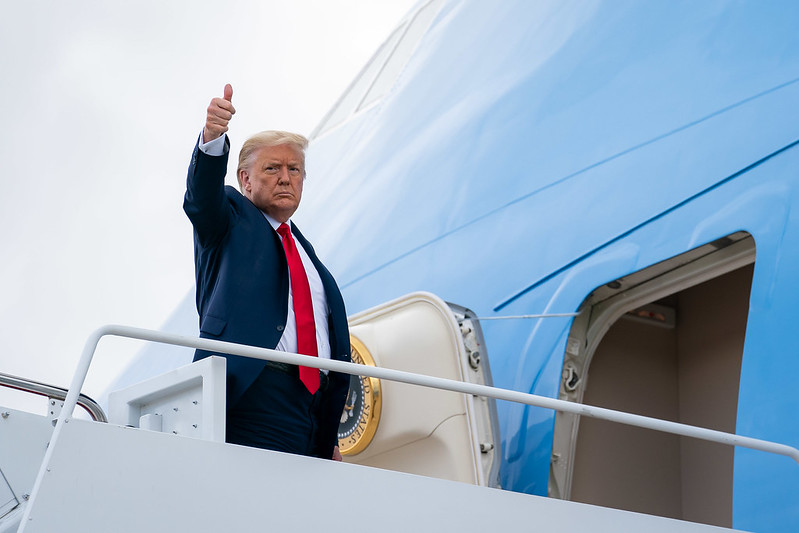
President Donald J. Trump boards Air Force One at Joint Base Andrews, Md. Friday, July 10, 2020, en route to Miami International Airport in Miami. (Official White House Photo by Tia Dufour)
All the President’s Antagonists
In the WSJ, Kimberley Strassel explains how President Trump’s forces have spent years analyzing how and what went wrong during Trump I, and how to devise plans “to avoid a repeat.” Ms. Strassel recommends readers not buy into the media hype that DOGE czar Elon Musk, for example, is running legally roughshod through Washington (for more on this, read below).
Don’t think this litigation is ad hoc, counsels Ms. Strassel. Activists and attorneys general have been meeting since Trump won the nomination, debating his likely moves, hiring lawyers, strategizing legal responses, and coordinating who would lead cases and where.
The resistance is on track to dwarf even the legal assault on Trump I—which was itself unprecedented in size and scope. KS leads off with the following stat:
State attorneys general filed 160 multistate lawsuits against the federal government in Trump’s first term, compared with 80 over Barack Obama’s entire tenure. The left tends to overstate its track record in first-term Trump litigation, using minor rulings to inflate its “percentage won” number, while glossing over the Trump team’s wins on big issues—like his travel ban, or major rules related to the Occupational Safety and Health Administration and religious freedom.
Still, Trump, I lost a shocking number of rulings –“many more than they should have.”
Ms. Strassel, can you tell us why you think this time is different?
Yes, indeed. Happy to. The legal fight has changed from eight years ago. Trump’s team has spent years analyzing what went wrong and devising plans to avoid a repeat.
- Focus. The sheer number of suits obscures that Democrats are concentrating the bulk of the efforts on a few areas where they see the best chance of scoring against Trump. For instance, a full half of the 16 immigration-related lawsuits filed so far target Trump’s efforts to revoke birthright citizenship—a protection the Supreme Court has upheld in past cases. Another eight target Trump’s changes to transgender policies, a legal area where the left hopes to push courts to expand on the Supreme Court’s 2020 Bostockruling against sex discrimination in the workplace. Yet most of the rest of the suits (including more than 16 related to Trump efforts to reform government and the civil service) are novel complaints against novel Trump actions, filed by this or that activist group hoping to score points.
- Substance. It’s worth making a distinction between lawsuits aimed at Trump’s executive orders on government reform and those aimed at the Department of Government Efficiency’s actions since inauguration. At least four lawsuits take aim at Trump’s Schedule F order, which seeks to reclassify thousands of senior civil servants to make it easier to transfer or fire them. Yet conservatives have spent years building the legal case for Schedule F, and even a Joe Biden regulation designed to thwart it never claimed it was illegal. And most of Trump’s initial orders have that sort of legal legwork behind them. That’s a bit different from DOGE’s recent attempts to gain access to Treasury Department payment systems, which has already provoked at least six lawsuits and is less charted legal territory.
- Legal Eagles. As mentioned earlier, don’t buy all the media hype that DOGE czar Elon Muskis running legally roughshod through Washington. The billionaire is well aware of the benefit of good lawyers, and he’s retained his fair share. ProPublica—even as it bemoaned DOGE’s “aggressive actions,” also acknowledged it had retained at least three “elite” lawyers—two of whom are previous Supreme Court clerks (one for Chief Justice John Roberts, one for Justice Neil Gorsuch). Does this mean DOGE will win every suit? No, but Musk’s team is aware of the need to comply with federal law.
- Purposeful Action. It’s also worth making a distinction between actions in which Trump believes he’s on solid legal footing and those where he has deliberately taken an action that runs counter to federal law for the purpose of provoking a Supreme Court review. In the latter category, consider Trump’s firing of National Labor Relations Board member Gwynne Wilcox, likely designed to test the constitutionality of restrictions on a president’s ability to fire members of “independent” agencies.
- Organization. The real chaos came in the first years of Trump’s tenure, as a team beleaguered by the recusal of former Attorney General Jeff Sessions, Robert Mueller’s investigation, and general inexperience made too many unforced errors.
Many of Trump’s legal defeats were the result of missed deadlines, sloppy briefs or a failure to adhere to the Administrative Procedures Act. This Trump team has upped its game. The risk this time is the scope of its ambitions, of spreading itself too thin to keep up. That may already be happening: the Justice Department failed to file a brief for last Friday’s hearing in a union lawsuit contesting Trump’s plans to put U.S. Agency for International Development employees on paid leave. Judge Carl Nichols (a Trump appointee) noted the lack of government information and issued a temporary order halting paid leave.
- Motivations. Not all lawsuits are inspired by the law. Democratic lawyers have learned the power of using anti-Trump lawsuits to build political name and success (see Fulton County prosecutor Fani Willis), while activists use litigation to gin up donations. Assume a fair portion of the latest anti-Trump lawsuits are rooted more in personal ambition than sound legal reasoning.
- The courts: Trump changed the face of the federal judiciary, and not just in terms of his number of judicial confirmations (234) or flipped circuits (three) or a larger conservative majority on the Supreme Court. He also put an emphasis on appointing judges with a deep knowledge of administrative law (which deals with government and regulations).
Today’s “resistance” lawsuits are headed into a judicial environment very different than that of 2017, one potentially more open to government reform. That isn’t to say Trump has a free pass—this Supreme Court has been more than willing to hand him defeats. But it does mean his legal antagonists will need more than demagoguery to win.
Kim Strassel’s talking points lead to a discussion of “ancillary damage.” Most often, she observes, Americans rely on the judiciary to settle legal disputes, not political ones.
While a few of the recent lawsuits focus on legitimate issues, the majority consist of overwrought objections to executive power filed in jurisdictions more likely to yield a liberal jurist who will keep the suits going. This is already producing clogged courts, strained legal opinions, more injunctions (including national injunctions, which the Supreme Court dislikes) and calls for appeals courts and the Supreme Court to engage in emergency proceedings.
Bottom line: The Trump legal team is far better prepared than it was eight years ago to defend itself in court. But don’t discount the cost, time and drama it will take to get to legal resolution.
If you’re willing to fight for Main Street America, click here to sign up for the Richardcyoung.com free weekly email.




